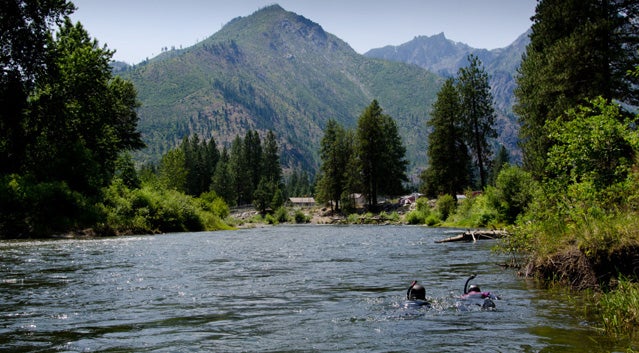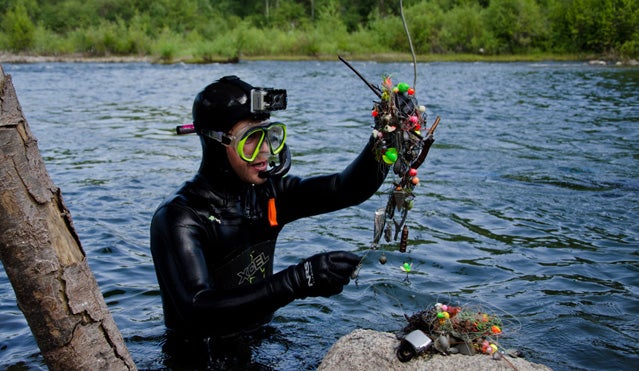
By Russ Ricketts
It all started innocently enough. My friend Matt told me about snorkeling with the salmon in our local rivers in the Cascade Mountains. His epic tales of huge fish, deep pools and fast currents held my attention. My wife and I had snorkeled in Hawaii—how could this be different?
Turns out, it is very different indeed. Sporting a mishmash of found and borrowed wetsuit items, I tentatively dove into the clear green water and was astonished. The currents pushed me over the rocky bottom effortlessly. Gentle rapids were suddenly an exhilarating roller coaster of bubbles. Long lazy drifts over cobbles and boulders revealed a world hidden under the familiar landscape of my local rivers. I was hooked.
Far from the vibrant colorful fish and coral of the usual tropical snorkeling experience, these mountain streams host much different underwater sights: migrating salmon patrolling the deep, playful trout snatching bugs, bedrock and boulders in fantastic shapes, bubbles and whirlpools. It’s a world Matt had first experienced on the job, performing snorkel surveys looking for bull trout for the U.S. Fish and Wildlife Service. “The first time we went was at night and I was provided a heavy, olive-drab drysuit, hoodie, wading boots, mask, snorkel and an underwater flash light,” he says. “We had to swim up a steep, rocky canyon in the Cle Elum River. I definitely remember being impressed by how badass my fellow biologists were.”
But it’s not all fish and rocks down there, as I quickly discovered. Humans have left their mark in these underwater corridors. Much of this refuse dates back to times when rivers were widely viewed as convenient and logical receptacles for trash. Sadly, many people still view rivers this way.
Seemingly pristine rivers harbor bottles, tools, barbed wire, car parts and sometimes the whole car. I have an affinity for junk, an eye for finding things. Far from your usual garbage, junk is the common version of treasure. With a mask and snorkel you can help clean up our country’s rivers and make a little spending money at the same time.
BOTTLES: They may break, but they don’t break down. I’ve collected both antique and modern bottles on my swims. The old ones are cool (and potentially valuable), but recycling new ones can generate a tidy profit.
FISHING TACKLE: I’m a fisherman, but I had no idea how terrible of a fisherman I was until I realized just how many fish there are down there. They are kept company by every lure and lead weight lost or abandoned by hopeful fishermen. Monofilament line can snare waterfowl and fish, so it should be removed whenever possible. Luckily, it generally comes packaged with other fish gear that holds some value. Matt and I picked up 52 pounds of lead in a two-hour swim. A 10-ounce sinker sells for $2.59. Do the math.
GOLF BALLS: What is it with hitting golf balls into water? Negatively buoyant, golf balls sink. Picking them up is fun and can be an easy way to pay for that sexy wetsuit (or golf lessons). Don’t worry, there’s plenty for everyone.
SUNGLASSES: Depending on when they were lost, picking up sunglasses will at least keep you in spare shades. I donate my finds to a raft guide who wears (and loses) them at a rate consistent with my finds.

No formal instruction exists for river snorkeling, though there are some . Swift water rescue training is a valuable tool, but proper judgment and a healthy dose of humility will go a long way toward staying safe and having fun. Start small and learn about river hydrology and hazard recognition—in other words, learn about the many ways a river can kill you.
Snorkeling in rivers can be an eye-opening experience, here’s what you need to get you started.
Mask, snorkel and fins can be bought cheaply at just about any sporting goods store, but be sure to try the mask on for fit and size your fins to accommodate booties, an almost mandatory comfort item in cold water and slippery rocks.
Wetsuits are what separate a hurried dip from a three-hour epic swim. Select a suit that is appropriate to your local water temperature. I strongly recommend a suit with a hood for cold water. Without it, rushing water can flood down your neck, chilling you to the bone in seconds.
Gloves and booties protect hands and feet from cuts and cold.
Common sense is also very useful. Don't go alone, keep your wits about you, and enjoy the ride.
Russ Ricketts and his wife, Leah Ricketts, live and river snorkel in Leavenworth, Washington. You can find more of their writing and photography at the .